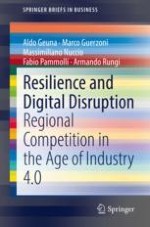2021 | Book
Resilience and Digital Disruption
Regional Competition in the Age of Industry 4.0
Authors: Prof. Aldo Geuna, Assoc. Prof. Marco Guerzoni, Assist. Prof. Massimiliano Nuccio, Prof. Fabio Pammolli, Assist. Prof. Armando Rungi
Publisher: Springer International Publishing
Book Series : SpringerBriefs in Business
